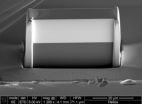Novel X-ray lens sharpens view into the nano world
DESY team produces innovative high-power X-ray lens
2015-06-01
(Press-News.org) This news release is available in German.
A team led by DESY scientists has designed, fabricated and successfully tested a novel X-ray lens that produces sharper and brighter images of the nano world. The lens employs an innovative concept to redirect X-rays over a wide range of angles, making a high convergence power. The larger the convergence the smaller the details a microscope can resolve, but as is well known it is difficult to bend X-rays by large enough angles. By fabricating a nano-structure that acts like an artificial crystal it was possible to mimic a high refracting power. Although the fabrication needed to be controlled at the atomic level -- which is comparable to the wavelength of X-rays -- the DESY scientists achieved this precision over an unprecedented area, making for a large working-distance lens and bright images. Together with the improved resolution these are key ingredients to make a super X-ray microscope. The team led by Dr. Saša Bajt from DESY presents the novel lens in the journal Scientific Reports (Nature Publishing Group).
"X-rays are used to study the nano world, as they are able to show much finer details than visible light and their penetrating power allows you to see inside objects," explains Bajt. The size of the smallest details that can be resolved depends on the wavelength of the radiation used. X-rays have very short wavelengths of only about 1 to 0.01 nanometres (nm), compared to 400 to 800 nm for visible light. A nanometre is a millionth of a millimetre. The high penetration of X-rays is favoured for three-dimensional tomographic imaging of objects such as biological cells, computer chips, and the nanomaterials involved in energy conversion or storage. But this also means that the X-rays pass straight through conventional lenses without being bent or focussed. One possible method to focus X-rays is to merely graze them from the surface of a mirror to nudge them towards a new direction. But such X-ray mirrors are limited in their convergence power and must be mechanically polished to high precision, making them extremely expensive.
An alternative means to bend X-rays is to use crystals. A crystal lattice diffracts X-rays, as the German physicist Max von Laue discovered a century ago. Today, artificial crystals can be tailor-made to sharply focus X-rays by depositing different materials layer by layer. From this building block comes the multilayer Laue lens or MLL, made by coating a substrate with thin layers of the chosen substances. "However, conventional Laue lenses are limited in their converging power for geometric reasons," explains Bajt. "To gain the maximum power, the layers of a MLL need to be slightly tilted against each other." As theoretical calculations have shown, all layers of such a "wedged" MLL must lie perpendicular on a circle with a radius of twice the focal length.
This rather specific condition could not be fabricated -- until now. Bajt's team invented a new production process, where a mask partially shields the substrate from the depositing material. In the half-shade of the mask a wedged structure builds up, and the tilt of the layers is controlled simply by adjusting the spacing of the mask to the substrate. The wedged MLL is then cut from the penumbra region. "Before us, no one came close to building such a wedged lens", says Bajt.
The researchers manufactured a wedged lens from 5500 alternating layers of silicon carbide (SiC) and tungsten (W), varying in thickness. The final lens cut from these deposits was 40 micrometres (millionths of a metre) wide, 17.5 micrometres thick and 6.5 micrometres deep.
The team tested their novel lens at DESY's ultra brilliant X-ray source PETRA III. The test at the experimental station P11 showed that the lens produced a focus just 8 nm wide, which is close to the design value of 6 nm. The tests also showed that the intensity profile across the lens is very uniform, a prerequisite for high quality images. The lens design allows to transmit up to 60 per cent of the incoming X-rays to the sample.
The scientists focussed the X-ray beam in just one direction, resulting in a thin line. Focussing in two dimensions to obtain a small spot can be done by simply using two lenses in line, one focusing horizontally and the other vertically. "Our results prove out our fabrication technique to achieve lenses of high focussing power. We believe we have the requisite control to achieve even higher power lenses," elaborates Bajt. "It appears that the long-sought goal of focusing X-rays to a nanometre is in reach." This will put X-ray imaging on par with the quality achieved with scanning electron microscopes, that typically have a resolution of 4 nm. The advantage is that X-ray imaging is not limited to viewing surfaces or extremely thin samples only, but can penetrate a sample. "Our novel lens concept will help scientists to peer deeper into the nanocosm and make previously inaccessible details visible," says Bajt.
INFORMATION:
Deutsches Elektronen-Synchrotron DESY is the leading German accelerator centre and one of the leading in the world. DESY is a member of the Helmholtz Association and receives its funding from the German Federal Ministry of Education and Research (BMBF) (90 per cent) and the German federal states of Hamburg and Brandenburg (10 per cent). At its locations in Hamburg and Zeuthen near Berlin, DESY develops, builds and operates large particle accelerators, and uses them to investigate the structure of matter. DESY's combination of photon science and particle physics is unique in Europe.
Reference
High numerical aperture multilayer Laue lenses
Andrew J. Morgan, Mauro Prasciolu, Andrzej Andrejczuk, Jacek Krzywinski, Alke Meents, David Pennicard, Heinz Graafsma, Anton Barty, Richard J. Bean, Miriam Barthelmess, Dominik Oberthuer, Oleksandr Yefanov, Andrew Aquila, Henry N. Chapman, and Saša Bajt
„Scientific Reports", 2015; DOI: 10.1038/srep09892
[Attachments] See images for this press release:


ELSE PRESS RELEASES FROM THIS DATE:
2015-06-01
A study analysing the Finnish homicide and prescription drug databases discovered that the use of certain drugs that affect the central nervous system are associated with an increased risk of committing a homicide. The greatest risk was associated with the use of painkillers and tranquillizing benzodiazepines, while anti-depressants were linked only to a slightly elevated risk. The study is the first one of its kind in the world.
Professor Jari Tiihonen's research group analysed the use of prescription drugs of 959 persons convicted of a homicide.
In the recent years, ...
2015-06-01
WASHINGTON, DC, May 27, 2015 -- Both men and women are more likely to cheat on their spouses the more economically dependent they are on them, according to a new study.
"You would think that people would not want to 'bite the hand that feeds them' so to speak, but that is not what my research shows," said study author Christin L. Munsch, an assistant professor of sociology at the University of Connecticut. "Instead, the findings indicate people like feeling relatively equal in their relationships. People don't like to feel dependent on another person."
According to ...
2015-06-01
Boston, MA -- After a prostate cancer diagnosis, eating a diet higher in red and processed meat, high-fat dairy foods, and refined grains--known as a Western diet--may lead to a significantly higher risk of both prostate cancer-related mortality and overall mortality compared with eating a diet rich in vegetables, fruits, fish, whole grains, and healthy oils, according to a new study from Harvard T.H. Chan School of Public Health.
The study, which appears online June 1, 2015 in the journal Cancer Prevention Research, offers insight on how diet may help improve survivorship ...
2015-06-01
More than 90 per cent of educational materials written for kidney disease patients is higher than an average patient's literacy, according to a new study published in the June issue of the National Kidney Foundation's American Journal of Kidney Diseases.
"Our study suggests most patient information materials are not fit for their intended purpose, and that organisations are producing materials that may be too difficult for their intended audience to understand," said Angela Webster, lead researcher and an Associate Professor Clinical Epidemiology at the University of ...
2015-06-01
ARLINGTON HEIGHTS, Ill., June 1, 2015 - An increase in the number of weight loss surgeries in the U.S. is beginning to have a ripple effect in plastic surgery, according to new data released today by the American Society of Plastic Surgeons (ASPS). Procedures specifically associated with massive weight loss, including tummy tucks, thigh lifts, breast lifts and upper arm lifts, grew at their fastest rate in four years in 2014, according to the report. That follows a similar increase in the growth of weight loss surgeries.
"We think there is a correlation between the two ...
2015-06-01
Boston - A new study by Boston University and Boston Medical Center (BMC) researchers reveals that U.S. states with stronger alcohol policies have lower rates of youth overall drinking and binge drinking. The study's results, published in the journal Pediatrics, further suggest that the link is largely a result of policies intended mostly for adults and their effects on reducing adult binge drinking.
The first-of-its kind study, led by a multi-disciplinary research team at BMC and the BU School of Public Health (BUSPH), reviewed data on 29 youth-specific and adult policies ...
2015-06-01
EVANSTON, Ill. --- Why do some people immediately burst into laughter after a humorous moment, while others can barely crack a smile? New research examining emotional reactivity suggests one of the answers may lie in a person's DNA.
In a new study linking a gene to positive emotional expressions such as smiling and laughing, researchers demonstrated that people with a certain genetic variant -- those with short alleles of the gene 5-HTTLPR -- smiled or laughed more while watching cartoons or subtly amusing film clips than people with long alleles.
Previous research ...
2015-06-01
VANCOUVER, Wash.--Washington State University researchers have found that the more hunter-gatherers smoke cannabis, the less they are infected by intestinal worms. The link suggests that they may unconsciously be, in effect, smoking medical marijuana.
Ed Hagen, a WSU Vancouver anthropologist, explored cannabis use among the Aka foragers to see if people away from the cultural and media influences of Western civilization might use plant toxins medicinally.
"In the same way we have a taste for salt, we might have a taste for psychoactive plant toxins, because these things ...
2015-06-01
Cancer Research UK scientists have discovered how giving a class of drugs called AKT inhibitors in combination with radiotherapy might boost its effectiveness across a wide range of cancers, according to a study published in the Journal of Clinical Investigation today*.
Tumours often grow so quickly that some of the cells do not have access to the body's blood supply, causing them to become oxygen-starved. This rapid growth usually sends signals to the cells to die, but in cancers with faults in a gene called p53 -- present in at least half of all cancers -- this signal ...
2015-06-01
A debate at this year's Euroanaesthesia meeting in Berlin will focus on whether laughing gas (nitrous oxide) should be banned from the operating room. The debate coincides with an article on the "Current place of nitrous oxide in clinical practice" published in the European Journal of Anaesthesiology, that concludes there is "no clinically relevant evidence for the withdrawal of nitrous oxide from the armamentarium of anaesthesia practice or procedural sedation." The article has been prepared by a special taskforce of the European Society of Anaesthesiology (ESA), which ...
LAST 30 PRESS RELEASES:
[Press-News.org] Novel X-ray lens sharpens view into the nano world
DESY team produces innovative high-power X-ray lens


